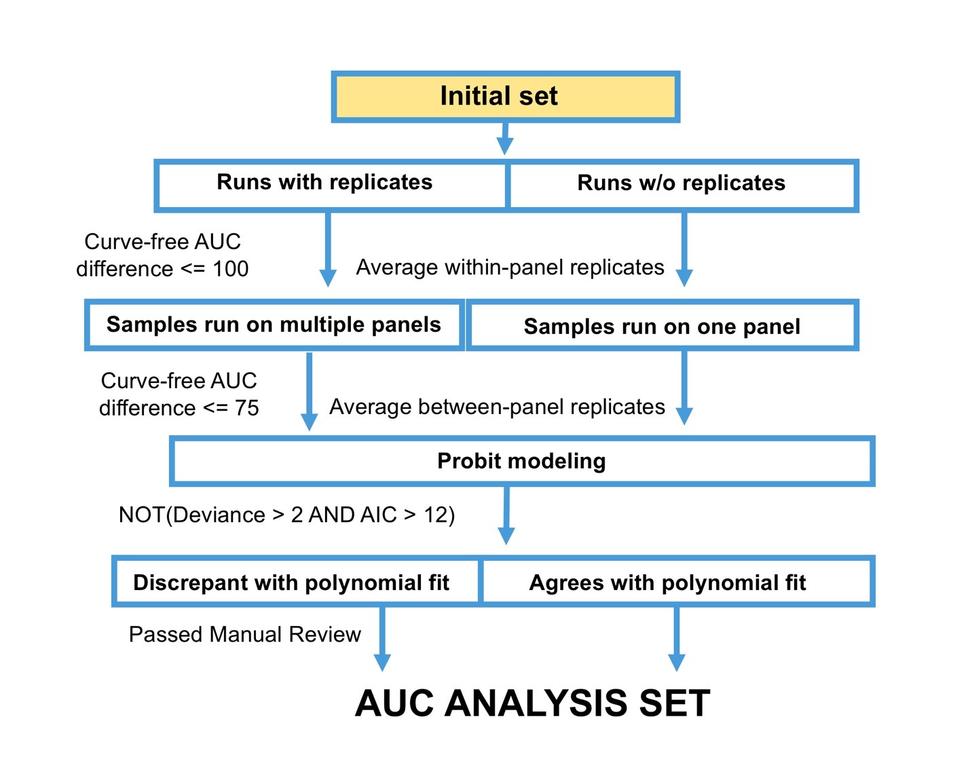Functional Genomic Landscape of Acute Myeloid Leukaemia
Principal Investigator
Brian J. Druker, M.D.
Contact
Jeffrey Tyner
Reference
Tyner et al. (Nature, 2018)
Data
- Raw/Analyzed Data (.zip file)
Beat AML program is a cohort of 672 tumor specimens collected from 562 patients. The study summarizes the initial findings of the analyses of ex vivo drug sensitivity. Samples were characterized using whole-exome sequencing and RNA sequencing and this data is available through NCI Genomics Data Commons. These datasets can be leveraged to address clinical, genomic, transcriptomic, and functional analyses of the biology of AML.
Experimental Approaches
Ex vivo functional drug screens were performed on freshly isolated mononuclear cells. In brief, 10,000 cells per well were arrayed into three, 384-well plates containing 122 small-molecule inhibitors. This panel contained graded concentrations of drugs with activity against two-thirds of the tyrosine kinome as well as other non-tyrosine kinase pathways, including mitogen-activated protein kinases (MAPKs), the pathway involving phosphatidylinositol-4,5-bisphosphate 3-kinase, AKT serine/threonine kinase 1 and mechanistic target of rapamycin kinase (PIK3C–AKT–MTOR); protein kinase AMP-activated (AMPK, also known as PRKAA1), ATM serine/threonine kinase (ATM), aurora kinases, calcium/calmodulin-dependent protein kinases (CAMKs), cyclin-dependent kinases (CDKs), serine/threonine protein kinase 3 (GSK3), IκB kinase (IκK), cAMP-dependent protein kinase (PKA), protein kinase C (PKC), polo-like kinase 1 (PLK1) and RAF proto-oncogene serine/threonine kinase (RAF). In addition, the library contained small-molecule inhibitors with activity against the BCL2 family, bromodomain containing 4 (BRD4), hedgehog heat shock protein 90 (HSP90), NOTCH/γ-secretase, proteasome, survivin, signal transducer and activator of transcription 3 (STAT3), histone deacetylase (HDAC), and WNT/β-catenin. Drug plates were created using inhibitors purchased from LC Laboratories and Selleck Chemicals and master stocks were reconstituted in dimethyl sulfoxide (DMSO) and stored at −80 °C. Master plates were created by distributing a single agent per well in a seven-point concentration series, created from threefold dilutions of the most concentrated stock resulting in a range of 10 μM to 0.0137 μM for each drug (except dasatinib, ponatinib, sunitinib and YM-155, which were plated at a concentration range of 1 μM to 0.00137 μM). DMSO-control wells and positive-control wells containing a drug combination of flavopiridol, staurosporine and velcade were placed on each plate, with the final concentration of DMSO ≤0.1% in all wells. Daughter plates were created using a V&P Scientific 384-well pin tool head operated by the Caliper Sciclone ALH 3000 and equipped with 0.457-mm diameter, 30-nl, slotted stainless-steel pins (FP1NS30). Daughter and destination plates were sealed with pealable thermal seals using a PlateLoc thermal sealer. Destination plates were stored at −20 °C for no more than three months and thawed immediately before use. Primary mononuclear cells were plated across single-agent inhibitor panels within 24 h of collection. Cells were seeded into 384-well assay plates at 10,000 cells per well in Roswell Park Memorial Institute (RPMI) 1640 medium supplemented with fetal bovine serum (FBS) (10%), L-glutamine, penicillin–streptomycin, and β-mercaptoethanol (10–4 M). After three days of culture at 37 °C in 5% CO2, MTS reagent (CellTiter96 AQueous One; Promega) was added, the optical density was measured at 490 nm, and raw absorbance values were adjusted to a reference blank value and then used to determine cell viability (normalized to untreated control wells).
With regard to data processing, a workflow in which the data normalization, curve fit parameters, and quality assurance/quality control steps are summarized below (Figure 1). A given sample was run on one or more panels and within each panel, the majority of drugs were run without within-panel replicates. Two steps were performed to harmonize these data before model fitting.
First, a ‘curve-free’ AUC (integration based on fine linear interpolation between the seven data points themselves) was calculated for those runs with within-panel replicates after applying a ceiling of 100 and a floor of 0 for the normalized viability. The maximum change in AUC among the replicates was noted and those runs with differences >100 were removed. Second, the remaining within-plate replicates had their normalized viability averaged subject to a ceiling of 100 and floor of 0. An additional set of ‘curve-free’ AUCs was computed for sample-inhibitor pairs run on multiple panels. The maximum change in AUC among the across-panel replicates was noted and those runs with differences >75 were removed. At this point, the within- and across-plate replicates for the normalized viability were averaged together and a ceiling of 100 was applied. From the steps above, the floor was already at 0. On the basis of the methodology used in the prior drug-combination study1, a probit regression was fit to all possible run groups using the model: (normalized viability/100) ~ 1 + log10 (concentration). For all groups there were n=7 dose-response measurements. The summary analyses of curve fit were inspected and cut-offs were devised removing all runs with an Akaike information criteria (AIC) > 12 and deviance >2. For inhibitors that were run using multiple concentration ranges, only the most-recent concentration range was kept. Finally, these data were compared to the AUC values from third-order polynomial fits. Those runs that were discrepant in terms of sensitive or resistant calls were manually reviewed as subject to removal.
Secondary Fusion Proteins as a Mechanism of BCR::ABL1 Kinase-independent Resistance in Chronic Myeloid Leukaemia
Principal Investigator
Brian J. Druker, M.D.
Contact
Cristina Tognon
Reference
Barnes et al. (Br J Haematol, 2023)
Data
- Raw/Analyzed Data (.zip file)
The 10 most frequently detected secondary fusions in samples from chronic myeloid leukaemia patients with BCR::ABL1-independent resistance were determined. Validation studies revealed differences with respect to proliferation rate and differentiation among other aspects, suggesting secondary fusions contribute to BCR::ABL1-independent resistance and may be amenable to combined therapies.
